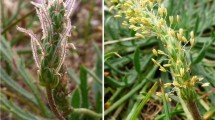Summary
Experiments and observations conducted during the past 90 years have provided conflicting evidence concerning the existence of a size difference between pollen grains containing an X chromosome (female-determining) and those containing a Y chromosome (maledetermining) in dioecious Silene latifolia. Were such a size difference to exist, this might explain, at least in part, the observation that X-bearing pollen tubes reach the ovary more quickly, on average, than Y-bearing pollen tubes. We tested for such a size difference by separating pollen collected from single anthers into three size classes: small, large, and random. Fruit set (number of pollinated flowers that set fruit) and seed set (number of seeds per capsule) did not differ for these three pollination treatments. Progeny sex ratios resulting from these three pollen size classes also did not differ significantly. Thus, pollen grain size is not affected by which of the two sex chromosomes is present. Our experiment is the first direct test of this relationship. Based on our results, size differences should not be invoked to explain competitive differences in male- and female-determining microgametophytes.
Similar content being viewed by others
References
Allen CE (1940) The genotypic basis of sex-expression in angiosperms. Bot Rev 6:227–300
Blackburn KB (1923) Sex chromosomes in plants. Nature 112:687–688
Correns C (1917) Ein Fall experimenteller Verschiebung des Geschlechtsverhältnisses. Sitzungsber K Preuss Akad Wiss 685–717
Correns C (1918) Fortsetzung der Versuche zur experimentellen Verschiebung des Geschlechtsverhältnisses. Sitzungsber K Preuss Akad Wiss 1175–1200
Correns C (1922) Alkohol und Zahlenverhältnis der Geschlechter bei einer getrenntgeschlechtigen Pflanze (Melandrium). Naturwissenschaften 10:1049–1052
Correns C (1928) Bestimmung, Vererbung und Verteilung des Geschlechtes bei den höheren Pflanzen. Handb Vererbungswiss 2:1–138
Frick B, Cavers PB (1989) Aberrations in sex expression in Silene latifolia. Am Nat 134:562–573
Lawrence CW (1963a) Genetic studies on wild populations of Melandrium. I. Chromosome behaviour. Heredity 18:135–148
Lawrence CW (1963b) Genetic studies on wild populations of Melandrium. II. Flowering time and plant weight. Heredity 18:149–163
Löve D (1940) Some studies on sex-determination in Melandrium rubrum. Sven Bot Tidskr 34:234–247
McNeill J, Crompton CW (1978) Pollen dimorphism in Silene alba (Caryophyllaceae). Can J Bot 56:1280–1286
Mangelsdorf PC (1932) Mechanical separation of gametes in maize. J Hered 23:289–295
Meagher TR (1988) Sex determination in plants. In: Lovett Doust J, Lovett Doust L (eds) Plant reproductive ecology. Oxford University Press, New York Oxford, pp 125–138
Nigtevecht G Van (1966) Genetic studies in dioecious Melandrium. II. Sex determination in Melandrium album and Melandrium dioicum. Genetica 37:307–344
Niizeki M, Saito K (1988) Increasing the transmission rate of the extra chromosome in a trisomic Nicotiana sylvestris by modifying the means of pollination. Theor Appl Genet 76:891–896
Peterson PA, Munson A (1962) B chromosomes and pollen size in maize. J Iowa Acad Sci 69:155–159
Prentice HC (1987) Analysis of the clinal variation pattern in Silene latifolia (Caryophyllaceae) pollen morphology. Plant Syst Evol 156:5–11
Prentice HC, Mastenbroek O, Berendsen W, Hogeweg P (1984) Geographic variation in the pollen of Silene latifolia (S. alba, S. pratensis): a quantitative morphological analysis of population data. Can J Bot 62:1259–1267
Santos JK (1923) Differentiation among chromosomes in Elodea. Bot Gaz 75:42–59
Santos JK (1924) Determination of sex in Elodea. Bot Gaz 77:353–376
SAS Institute (1987) SAS/STAT guide for personal computers, version 6. Cary, NC
Singleton WR, Mangelsdorf PC (1940) Gametic lethals on the fourth chromosome of maize. Genetics 25:366–390
Sinoto Y (1929) Chromosome studies in some dioecious plants with special reference to the allosomes. Cytologia 1:109–191
Tischler G (1925) Ein Beitrag zum Verständnis des Certations-Problems bei Melandrium. Planta 1:332–341
Warmke HE (1946) Sex determination and sex balance in Melandrium. Am J Bot 33:648–660
Warmke HE, Blakeslee AF (1939) Sex mechanism in polyploids of Melandrium. Science 89:391–392
Westergaard M (1958) The mechanism of sex determination in dioecious flowering plants. Adv Genet 9:217–281
Winge O (1923) On sex chromosomes, sex determination, and preponderance of females in some dioecious plants. C R Trav Lab Carlsberg 15:1–25
Author information
Authors and Affiliations
Rights and permissions
About this article
Cite this article
Carroll, S.B., Mulcahy, D.L. The relationship between pollen grain size and progeny gender in dioecious Silene latifolia (Caryophyllaceae). Sexual Plant Reprod 4, 203–207 (1991). https://doi.org/10.1007/BF00190006
Issue Date:
DOI: https://doi.org/10.1007/BF00190006




